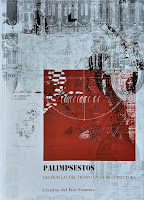Palimpsestos: Las Huellas del Tiempo en la Arquitectura (2022)
(Palimpsests: The Traces of Time in Architecture)
Christina del Río Fuentes
Prologue: Alfonso Carvajal
93 pages
If when you wander down a street, whether in your hometown or somewhere half a world away, you tend to find your attention captured by evidence in the buildings of earlier structures or uses – incongruities in facades along a block, differences in the style from the street level to higher stories, or fading, wall-painted ads for former stores – then architect Christina del Río Fuentes has written a book that will speak directly to your heart. Her marvelous essay Palimpsestos: Las Huellas del Tiempo en la Arquitectura (Palimpsests: The Traces of Time in Architecture) invites us to seek out such accumulations of architectural changes in a place, and to consider what they reveal about that location’s inhabitants and the evolution of their hopes and dreams.She opens by explaining her use of the word Palimpsests, describing it as coming from the Greek palimpsestos ‘scaped again’, originally meaning a writing material (such as a parchment or tablet) that has been used one or more times after earlier writing has been erased. But the word has also come to mean, quoting from Merriam-Webster, “something having usually diverse layers or aspects apparent beneath the surface.” Del Río Fuentes ultimately finds both of these meanings applicable, as the diverse layers of architectural style in a place often result from earlier structures that have been repurposed or built over.
After first acknowledging the evidence of lasting human impact on the natural world (we do, after all, live in an age that some have labeled the Anthropocene), del Río Fuentes focuses for most the book on the kinds of palimpsests found in the evolution of cities. She describes three types of such impacts on a city’s architectural style: scars, “vestiges of the past that have remained present,” (36) say after a place has been rebuilt in the wake of a catastrophic fire; strata, groups of architectural elements that have become integrated with other groups that come before or after, as cities evolve to reflect changes in their inhabitants’ needs and desires; and, collage of time, in which buildings remain from the past but have been renovated to reflect a changed cultural vision of a city’s inhabitants, for which she provides a particularly vivid example of the present-day Roman-catholic cathedral in Cordoba that was originally a mosque build by the Moors. She closes her essay with examples from cities that exhibit each of these architectural histories.
By integrating cultural and historical considerations with the physical reality of the architectural styles, del Río Fuentes brings cityscapes alive in her essay. What at first glance appear as mute collections of buildings reveal themselves as
[not] a constructed territory, but rather an accumulation of distinct transformations. They appear as dynamic cities in which their development, their changes, give rise to unforeseeable models. (47)
By demonstrating that these transformations have analogues in the work of artists, she reveals how the evolution of the structure of a place is driven by its inhabitants, and that the dynamism of the architecture comes out of their evolving cultural norms and priorities.
After reading Palimpsests, you’ll surely see your hometown differently, becoming attuned to the mixture of styles present, the scars sometimes left as new replaces old, and the variety of surprising layers hidden often in plain sight.
Other notes and information:
While I was in the middle of Palimpsests, I happened to read Jacinto Antón’s interview of the photographer Isabel Muñoz in El País Semanal (9 July 2023, The Dawn of Civilization, Pictured at Night) LINKLINK regarding her stunning pictures of the Turkish site Göbekli Tepe, which triggered a direct connection. Göbekli Tepe is described as “a meeting place built by groups of hunter-gatherers in the dawn of the Neolithic age (Neolithic preceramic, 9600-7000 BC), during the transition to the first permanent settlements.” In the article, a Turkish archaeologist, Necmi Karul, comments that
They are spaces of socialization and memory. In the pillars, we see images, for the large part of animals, that must have formed part of a collective memory. The buildings are architecture living and renewable (we see that the reliefs were replaced), they are living constructions, that indicate to us a new style of living. (italics mine)
To my understanding, Palimpsests is only available in Spanish. But it’s a relatively short essay, and if one knows some Spanish, and is willing to proceed with a dictionary at one’s side, it can be tackled. (Translations of the quotes above from the book, as well as from the magazine article, are mine.)
Have you read this book, others by this author, or even similar ones by other authors? I’d enjoy hearing your thoughts.
Other of my book reviews: FICTION Bookshelf and NON-FICTION Bookshelf

No comments:
Post a Comment